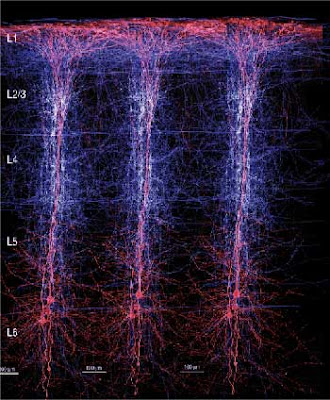Neurons in green are over expressing a key gene that abnormally segregates them from other neurons (red and blue) within a developing column in the cerebral cortex. Credit: Yale University
"A molecular mechanism" has been identified by researchers at Yale University, according to Bill Hathaway of Yale University , who was publicizing an article in the Sept. 16th online issue of the journal Nature about the Yale researchers accomplishment. The molecular mechanism has been determined to regulate the correct blending of neurons - brain cells that carry out the properties of the mind; during the structural arrangement of columns that are necessary for the functioning of the cerebral cortex, or as it is more commonly referred to as the Cerebrum. The outermost portion of the Cerebrum measures 2-6 mm in depth and is often referred to as the gray matter of the brain.
The Outer Area of the Human Brain: Google Images
"The principle unit of organization is the cortical column. Within each column, neurons located in each of the layers within a given column respond best to a single class of receptors, and all of the neurons respond to stimulation applied to the same local region of the body surface. Adjoining columns representing the same body surface have different physiological properties, such as being rapidly adapting or slowly adapting to sensory stimulation."
Neuroscientists have long suspected that the ability of the cerebral cortex to process information relies on groupings of neurons that form vertical columns whose proper functioning is critically dependent on results obtained from the correct amalgamation of neurons.
Brain neurons: flickr.com
Neuroscientists suspect that if the mixture of neurons in the column is imprecise, the most likely outcome would be the appearance of severe cognitive problems including types of autism and mental retardation. To date, researchers have been unable to find the particular molecular mechanism that controls the intermixing of neurons that is intended to prevent cognitive difficulties."The cortical column, also known as the minicolumn, is the basic functional unit of the cerebral cortex. The column is oriented perpendicular to the cortical surface, and consists of six distinct layers of neurons. Each cortical column consists of about 100 neurons. All neurons inside the column are tightly connected, although neurons connections extend to adjacent columns and columns far across the cortex and into subcortical areas, particularly the thalamus. Cortical columns are capable of memorizing relations and performing more complex operations than individual neurons; to extend the information processing analogy, if a neuron is analogous to a logic gate, a cortical column is more analogous to a small subroutine."
The Yale group of researchers was "led by Pasko Rakic, professor and chairman of the Department of Neurobiology and head of the Kavli Institute for Neuroscience."
Yale spokesman, Bill Hathaway, in his press release, elaborated on the researchers' description of their approach to investigating the molecular mechanism: "Using the most advanced molecular technology, the Yale team showed that during neuronal migration, the intermixing of neurons within column depends on the expression levels of two genes - A-type Eph receptor and ephrin-As, a ligand, or molecule that binds to the receptor. Neuronal cells failed to move laterally into proper columns in mice lacking the ligands or receptors."
The Yale press release elaborated that: "Masaaki Torii, the first author of the paper, said he was surprised to find that the tiny lateral shift of migrating neurons controlled by these molecules plays such a pivotal role in the normal cortical development."
"This so far unrecognized mechanism for lateral neuronal dispersion seems to be essential for the proper intermixing of neuronal types in the cortical columns, which, when disrupted, might contribute to neuropsychiatric disorders " explained team leader Rakic.
Many scientists and researchers have expressed their temptation "to think of the cortical column as a basic universal computational unit of the cortex."




No comments:
Post a Comment